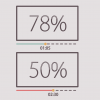Here at Sparksight, character animation is something we’re very familiar with. Creating animated characters in the place of text, iconography, or graphics can add a great personal element to your video. When an animator starts to design a new character in After Effects, one of the first questions we ask ourselves is, “How am I going to rig this character?”
Put simply, a “rig” is sort of like the skeleton of an animated character. There are simple and stroke-based rigs that are very popular in commercial motion graphics, and more advanced Inverse Kinematic rigs (IK rigs) that account for the relationship between multiple joints and digits. More advanced rigs often require third party plugins or scripts in After Effects to make an animator’s job easier. A rig ultimately determines how, and by what parameters, a character will be animated.

Here’s an example of an Inverse Kinematic rig created using Duik by DuDuf
At Sparksight, we’re big fans of stroke-based rigs. They’re fun, simple, and contribute to the overall style of a character. Below are two of our favorite stroke-based rig examples from animated videos we’ve made for our clients.


Stroke-based rigs are created using shape layers in After Effects. For those of you who are unfamiliar with the workflow of After Effects, a shape layer is exactly what it sounds like: A layer for shapes. When shapes are created in After Effects, they have two distinct properties: a fill and a stroke. The fill can be thought of simply as the interior of a shape, while the stroke as the outline or exterior. Both can be edited independently, or can be omitted altogether, leaving only a stroke, or only a fill. The limbs used in the stroke-based rigs above were created using only strokes, with no fill.
While we love animating characters using stroke-based rigs, the process can become complicated very quickly. The rig is created by parenting each of the limbs to the torso or mid-section of the character, meaning when the torso is moved or rotated, all of the limbs attached move with it. The limbs are then animated by keying and editing the “stroke” and “rotation” parameters. Where this becomes complicated is when multiple strokes are needed to create one limb, as in the woman seen above.

One stroke must be animated, while the other parameters are parented to its animated properties using the “pickwhip” tool. There is also the hassle of dealing with stroke caps (i.e. round or flat) and trim-paths on multiple strokes.
So how do we deal with this?
Enter BattleAxe, who has managed to solve both of these problems with their two incredible After Effects scripts: RubberHose and ButtCapper (Yes, ButtCapper).
I discovered BattleAxe a couple of weeks before the release of their amazing new rigging tool, RubberHose, after seeing a promo video announcing its upcoming release on Vimeo. This video led me to another video explaining BattleAxe’s already available (and free) script, ButtCapper, which eliminates the tedious “drilling-down” required to change a stroke’s cap in After Effects (a process hilariously outlined in the video).
I immediately downloaded the free, and laughably named ButtCapper script, and it worked perfectly. The UI is simple and small, and can fit anywhere in my relatively crowded After Effects window.

I was so pleased with ButtCapper, that I went ahead and pre-ordered RubberHose that same day, and downloaded it on the day of its release.

While the video linked above outlines all of the great things about RubberHose in a quick 30 seconds, I wanted to share my thoughts on the new script, and how it directly addresses any gripes I previously had when creating stroke-based rigs with shape layers.
Simply put, it’s easier, faster and way more fun. Rather than creating multiple shape layers and strokes for one limb, and animating the strokes with finicky Bezier handles, the RubberHose system creates controllers on either end of a stroke, which can easily be grabbed and moved to create a realistic bouncy animation.


Multiple shapes can be created inside of one “hose Layer,” allowing all of the shapes in a limb to be controlled by the same set of controllers, eliminating the need for complex parenting of limbs. A super handy “auto Flop” switch allows limbs to bend in both directions for an awesome cartoony effect, a feature absent from popular advanced IK rigging tools. Shoes or hands can be parented to the limbs’ controllers, and can be set to auto-rotate naturally along with the limbs, rather than having to key their parameters individually. All of these features and many more are outlined in a series of videos on BattleAxe’s website, that released on the day of RubberHose’s launch.
Here’s what I came up with in just a little more than one afternoon of working with RubberHose:
 I’m excited to continue practicing with this new script in upcoming projects and unlock all of its incredible potential! Do you use any plugins or scripts in After Effects that you would recommend? Let me know in the comments section!
I’m excited to continue practicing with this new script in upcoming projects and unlock all of its incredible potential! Do you use any plugins or scripts in After Effects that you would recommend? Let me know in the comments section!
My overall review of RubberHose:
A+
10/10
Totally worth the $45
And don’t forget ButtCapper, either!



